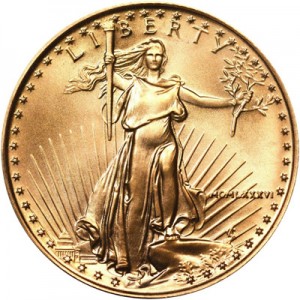The American Gold Eagles Approach Their 35th Anniversary With a Design Change Looming
 Bullion.Directory precious metals guest post 19 May, 2020
Bullion.Directory precious metals guest post 19 May, 2020
By Nick Adamo
President at Bullion Shark LLC
During the first decade after it became legal again for Americans to own gold coins in 1974, the South African gold Krugerrand dominated the world gold coin market, accounting for 90% of coins traded.
Around this time, Rep. Ron Paul led an effort to develop an American gold investment coin that would be an alternative to the Krugerrand, which was created through the Gold Bullion Coin Act of 1985 after several other measures failed.
Starting in 1986, the U.S. Mint began issuing American Gold Eagles in four sizes — $50 coins containing one ounce of gold; $25 coins with one-half ounce of gold; $10 coins with one-quarter an ounce of gold; and $5 coins with one-tenth an ounce.
Each was composed of 22-karat gold, the same as the Krugerrand, and weighed a little more than its gold weight because the coins, which contain .9167 fineness gold, also include .0533 ounces of copper and .03 of silver. The legislation also stipulated the that coins had to be produced using gold mined in the U.S.
In the almost 35 years since the coins were introduced, they have continued to dominate the U.S. gold coin market and are also popular in other countries.
From the beginning the coins were issued in two formats – business strike bullion coins aimed mainly at gold investors that with time also became popular collectibles and proof coins aimed at collectors, which can also be included in precious metal IRA accounts. Both versions are collected both raw and graded.
 For their designs then-Treasury Secretary James Baker delighted numismatists by selecting the iconic and beloved 1907 Augustus Saint-Gaudens $20 gold double eagle obverse depiction of Liberty striding confidently towards the future and carrying a torch in her right hand and an olive branch in her left hand.
For their designs then-Treasury Secretary James Baker delighted numismatists by selecting the iconic and beloved 1907 Augustus Saint-Gaudens $20 gold double eagle obverse depiction of Liberty striding confidently towards the future and carrying a torch in her right hand and an olive branch in her left hand.
To remain true to the original, the coins featured Roman numerals for their date until 1992, and all inscriptions were contained on the reverse, which featured an original design called Family of Eagles by Miley Busek and engraved by Sherl Joseph Winter. The design shows a male eagle carrying an olive branch and flying above a nest with a female eagle and hatchlings.
Next year, when the series turns 35, there will be a new reverse design on bullion versions of the American Gold Eagle that will also feature state of the art anti-counterfeiting measures that are being developed.
The Mint has not yet announced what the new design will be or whether or when it will be used on the collector issues.
Burnished coins
In 2006 a new line of collectible versions of the coin struck on specially burnished planchets that gives them a satiny finish debuted and are known as burnished uncirculated coins.
These coins, like all the proof issues, are struck at the West Point Mint and feature a “W” mintmark. Although they do not have preset mintage levels and are produced to demand, some of these coins were issued in very small numbers for a modern coin and are highly collectible.
They were not issued in 2009 and 2010 when demand for gold bullion outstripped the Mint’s supply of gold planchets. In addition, the fractional burnished coins smaller than an ounce were only issued from 2006 to 2008.
In particular, the 2008-W $10 coin with a mintage of 8,883, the 2007-W $25 coin with a mintage of 11,455 and the $50 coins from 2012 and 2017 with respective mintage of 5,829 and 5800 are highly sought by collectors.
Only two special anniversary sets have been issued to date – the 10th anniversary West Point Mint set in 1995 that included the set of four proofs from that year plus the key date 1995-W proof Silver Eagle and the 2006 20th anniversary set that includes the $50 coins from that year in three finishes: burnished uncirculated, proof and the only reverse proof coin of the series that was only available in that set that has a mintage of 10,000 coins (actual sales of 9,996).
The reverse proof coin has maintained a strong premium since its issue as a unique coin needed by many different type of collectors.
Collecting strategies
Because gold is not cheap and its spot price has been rising in recent years and because the Gold Eagle is issued in four sizes and multiple finishes, those who wish to collect the series can’t afford to buy every coin and need to decide what to focus on.
An affordable approach would be to put together a type set of one or more denominations, and graded examples might be a good way to do that.
The $50 coins would be the most suitable since they were issued in each finish: bullion, proof, burnished and reverse proof.
For those interested in building a complete date set of one or more versions of the coin, it is advisable to select one of the four denominations. Buyers have a long-standing preference that is reflected in sales numbers for either the largest coin, the $50 one-ounce piece, or the most affordable, the $10, tenth-ounce coin.
For this reason, mintages of the other two coins tend to be lower most years, especially for the bullion coins.
The $25, half-ounce bullion coins include some issues with low mintages that sell for substantial premiums over their melt value such as the 1991 with only 24,100 minted and 1990 with 31,000 minted. Those two coins are not easy to locate and have had time to appreciate.
Examples graded MS70 of the 1991 issue are worth at least $6,000. The 2019 issue, the new second-lowest for the series at 30,000, is also seeing its value increase.
There are also varieties of some Gold Eagles with the most significant being the 1999-W $5 and $10 bullion coins that were inadvertently struck on unpolished proof dies at a time when demand for gold bullion was spiking because of the approaching Y2K computer issue.
Those coins have respective estimated mintages of 14,500 and 10,000 and raw coin values of about $900 and $1800.
In the coming months collectors of American Gold Eagles have a lot to look forward to from the special World War II first-ever privy mark coins with an incredibly low mintage (that will be covered here soon) to a new reverse design.
And chances are good that the Mint will release a special set next year for the coin’s 35th anniversary.










 Material provided on the Bullion.Directory website is strictly for informational purposes only. The content is developed from sources believed to be providing accurate information. No information on this website is intended as investment, tax or legal advice and must not be relied upon as such. Please consult legal or tax professionals for specific information regarding your individual situation. Precious metals carry risk and investors requiring advice should always consult a properly qualified advisor. Bullion.Directory, it's staff or affiliates do not accept any liability for loss, damages, or loss of profit resulting from readers investment decisions.
Material provided on the Bullion.Directory website is strictly for informational purposes only. The content is developed from sources believed to be providing accurate information. No information on this website is intended as investment, tax or legal advice and must not be relied upon as such. Please consult legal or tax professionals for specific information regarding your individual situation. Precious metals carry risk and investors requiring advice should always consult a properly qualified advisor. Bullion.Directory, it's staff or affiliates do not accept any liability for loss, damages, or loss of profit resulting from readers investment decisions.

Leave a Reply